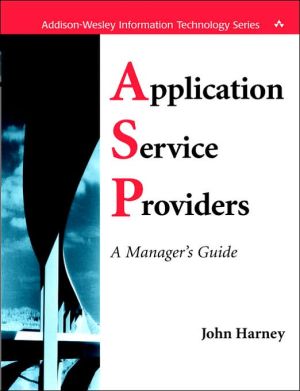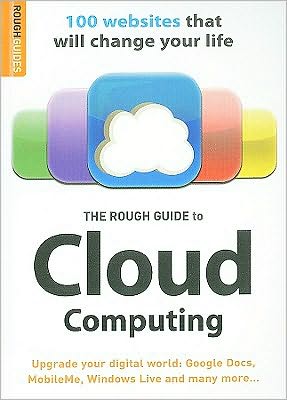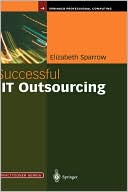Application Service Providers (ASPs): A Manager's Guide
Application Service Providers (ASPs) lease hosted software applications over broadband networks to companies of all sizes as a faster, less expensive, and simpler alternative to installed applications. ASPs especially benefit small-to-mid-size businesses (SMBs) because, until these services existed, most of these organizations could not afford enterprise applications. While the ASP industry is still young, experts predict that it will soon become amulti-billion dollar industry fueled largely...
Search in google:
This guide to leasing hosted software services from an application service provider (ASP) explains the ASP business model, and defines what technology, security, service level agreements, pricing models and technical support to expect from an ASP. The different types of ASPs are identified along with their strengths and weaknesses. Annotation c. Book News, Inc., Portland, OR (booknews.com)
I first heard about Application Service Providers (ASP) about three years ago from Marty Gruhn at Summit Strategies. I think I was doing an article on e-business, and she suggested I look into the value proposition of what she called Internet Application Hosting. She was hot on IAH—one of the few people who really were—and thought they would dramatically change the face of corporate computing. I followed her advice, and found ASPs so compelling that I started researching and writing compulsively about any ASP-related operations. Then ASPs and ASP-wannabes started seeing my articles and, of all things, began calling me for advice. This was a wonderful thing because I actually got to visit some data centers and talk shop with the people in the trenches.\ When I was an editor of several computing magazines, software companies would bring their new programs to the magazine offices and demo them for me. That was a great part of the job because we would often actually brainstorm problems they were having like pricing strategies, the right target customer, competition and so on. With ASP hosted applications, I could actually access the application right over my Internet connection—the techies just needed to give me a user ID. Later I could go out to the data center and see the "backend" of the operation—data center, network, security, storage and so on. Very impressive—like going to the Air and Space Museum at the Smithsonian.\ At the time there were only about 50 ASPs out there, the press had not become obsessed with covering the phenomenon and there were no formal organizations whatever devoted to ASPs. Indeed, many ASPs were glad for any kind of validation, guidance and marketing exposure.\ By my own informal estimate, there are now between 1000 and 1500 ASP-related businesses (called xSPs in the argot of the industry) out there, and it seems several new ones turn up every week. By any measure, the overnight explosion of the ASP industry is unprecedented. But what is unusual about it is that the numerical proliferation of ASPs is also complemented by their prolific diversification. ASPs already serve most vertical markets like finance, manufacturing and health care with most major enterprise applications like e-commerce, ERP and CRM, sales automation and collaboration. They also offer a full spectrum of IT platforms and networks. Usually a new technology approach penetrates one or two vertical markets and, once established, then migrates to other markets that are most similar to those already conquered. ASPs, like other generically horizontal "consumer-oriented" technologies such as PCs and mobile phones, is inherently more democratic.\ ASPs' more democratic approach—the diversity of market focus and freedom of opportunity in the industry—might be its greatest strength. As yet, there is no 800-pound gorilla that can scoop up any promising new ASP and incorporate its winning tools and methods into its competitive arsenal. The industry is still pretty wide open—a good idea executed well can go far. But that democratic approach might also be the industry's greatest weakness—anyone with an idea and some money can launch an ASP. The upside of such a situation is that it fosters a boom in all manner of providers. So customer organizations of all sizes in different markets can now take advantage of a truly virtual computing paradigm that cuts their costs and risks and lets them exploit powerful applications that many could not afford as installed solutions. The downside is that, because anyone can play in this game, some amateurs stumble into the fray, try to get rich quick, fail and disappoint their customers.\ Because ASPs received the unavoidable hype attendant on such accelerated growth, some entrepreneurs looking for quick profits launched ASPs with business plans that proved—or will prove untenable. By my own informal count, maybe 10 to 20 ASPs have gone under for various reasons like poor business plans, dried-up funding, a bad economy and increased competition. In the wake of 2000's dotcom flameouts on NASDAQ, any new virtual e-business plan is receiving exasperatingly close scrutiny by venture capitalists. The same goes for new e-business ventures looking for stockholders at IPO time. And computing analysts and press tend, sometimes, to focus on the dramatic disaster—because it makes for a good story— than the relatively unexciting success—even though it makes for happy customers. The result is that the same media overexposure and vendor hype that unrealistically inflated customer and investor expectations for ASPs may now have unrealistically deflated them.\ I have followed IT segments like imaging/workflow, document management, knowledge management, wireless Internet access, videoconferencing, PDAs, ATM and others where the major players have not shown a profit for five years or more and whose stock performance has been dismal. But, when the market caught up with them, they could hardly handle all the business coming their way.\ I cannot emphasize this enough—such is the nature of a new IT market. Experts have documented that markets go through phases as they mature—they are born, proliferate, consolidate and stratify into leaders and laggards. The ASP market is not even three years old —it has not even finished the proliferation phase. It will inevitably consolidate and stratify into established major players and many other niche ones. In the meantime, do the math—of 1000 to 1500 existing ASPs, under 20 have had problems. In my view, that's an incredible success rate. Indeed, compared to the average recent success rate of small businesses in the U.S.—about half fail—it's phenomenal.\ Keep your eye on the long-term perspective. Gartner Group estimates that worldwide revenues of ASPs will be $25.3 billion in 2004. Meanwhile, IDC predicts worldwide revenues for the xSP market (ASPs, MSPs, MsecPs, etc.) will quadruple from $106 billion in 2000 to more than $460 billion in 2005.\ The mainstreaming of virtual computing is inevitable. As the ASP industry matures, market caps will boom, major players will buy smaller niche players, financially unstable players will go out of business or get acquired, and the industry will settle into the approximate form it will maintain for many years after. In the meantime, the challenging "pull" for you, the customer, is finding a solid ASP that will give you a good deal now and be around in five years. While the competitive "push" for you is choosing a viable ASP before your competition does and undercuts your value proposition by doing things like saving lots of money on hosted IT services and getting to market faster. This is particularly true for Small-to-Medium-Size Businesses (SMBs), many of whom till now could not afford any expensive installed enterprise systems like ERP and therefore competed at a disadvantage with Global 2000 firms that could.\ As with any new product, customers must perform due diligence when engaging an unknown vendor. I wrote this book to guide you through the process. I have purposely skirted granular current events like the stock performance of individual ASPs. I believe increased competition, the Darwinistic thinning of the ASP herd, and the inevitable merger and acquisition activity of major information technology and telecom vendors like Microsoft and AT&T with complementary ASPs who need cash will strengthen the ASP brand. If the big boys are smart, they'll let their new partners do what they do best—innovate. If individual ASPs are smart, they won't be unrealistically stubborn idealists and risk their customers' and stockholders' financial welfare by remaining independents with unstable cashflow. That said, I think your best buying strategy now is diligently educating yourself about ASPs' business strategy and technology infrastructure and intelligently and exhaustively evaluating ASP candidates so you engage an ASP whose services best match your requirements and whose long-term success is most likely.\ If I had to choose fundamental criteria for an ASP's success, they would be solid management, mastery of the technology and a respectable client base. At this early stage of the industry, profitability —while important—is of secondary importance to number of clients. If an ASP has oversold itself to win clients, then its references will tell the story. Whereas numerous satisfied clients translate to cashflow now— the number one preoccupation of any new business—and profitability and solid stock valuation later.\ With that in mind, this book is written for C-Level executives and managers who are considering leasing hosted services from an ASP. It introduces you to the telecom and computing climate and players that spawned the ASP movement, explains the ASP business model, and tells you in pretty fine detail what technology, security, service level conditions and customer service and tech support you should require of an ASP. I also define, and provide examples of, different types of ASPs—like Pure Play ASPs and Full Service Providers—as well as xSPs—like Infrastructure Service Providers and Management Service Providers—whose services might best suit you. I also explain the various pricing models of ASPs and suggest which ones are best for certain types of organizations according to the activities they will be performing. And I discuss the ramifications of ASPs on the traditional IT reseller channel as well as explain the new channel that ASPs offer as an alternative. I also make some educated guesses about winning and losing ASP strategies and about business and IT trends that will affect the ASP industry in the next few years.\ That's in the chapters themselves. The Appendices offer selected ASPs that I've organized according to what kind of xSP they are, what vertical markets they serve and what applications they host. I've also included a list of ASP organizations and publications that host exhaustive ASP Directories and offer current news and analysis as well as invaluable information about standards and the ASP state-of-the-art.\ I would also implore you to address the pertinent questions in Appendix E, Defining Your ASP Requirements. I created these questions as a checklist you can go through with your ASP candidates to guarantee that the ASP hosted applications you will lease—as well as things like value-added services—are exactly what you need at the price you want to pay. But they also are designed to get the ASP to open up about its business partners, market strategy, channel development and other factors that will ensure their long-term success.\ In fact, if I were consulting for a client who wanted to hire an ASP, I would suggest the decision-makers use the book in the following way. First, read Chapters 1-13 to make sure you understand your ASP candidates' market positioning, ASP or xSP Type, Price Model and so on. Once you understand the industry terms, baseline features and functions and competition, you can intelligently assess each ASP's value proposition and comparatively shop among various candidates. Next, peruse the appendices of ASPs by type, application and market. I selected these ASPs because they had a certain visibility and geographic diversity, but that is my only bias. This will give you a few vendors to call to get your feet wet. Then I'd suggest you look through the ASP directories at the various organizations and portals I list in the appendix on ASP organizations and publications. These offer an array of ASPs of every stripe that you can research to your heart's content. I have a similar database of ASPs culled from numerous sources, so contact me if you like. Finally, go through the pertinent questions in Defining Your ASP Requirements with your top ASP candidates. This is the most important step in your selection process because at least 95% of anything you need to know about a potential ASP partner will be elicited from them by asking these questions. What you don't know you don't know usually comes back to haunt you later—that's why I've been so comprehensive in creating this checklist.\ It's been my experience that, when a buying team uses such a methodology, it becomes very clear very quickly which candidates are untenable. Your only problem then will be how to choose the best of the best. I think you'll agree that getting to face that dilemma is worth the price of the book. I wish you the best of luck.\ \
PrefaceAcknowledgmentsCh. 1The Tangled Roots of the ASP Phenomenon1Ch. 2The ASP Coalition - No Single Vendor Can Do It All15Ch. 3The ASP Hardware Platform35Ch. 4The Data Center47Ch. 5The ASP Network59Ch. 6Varieties of ASP79Ch. 7Security Issues for ASPs103Ch. 8ASP Service-Level Agreements125Ch. 9ASP Pricing Models139Ch. 10ASP Customer Service and Technical Support149Ch. 11Enabling Technologies for ASPs171Ch. 12The ASP Channel195Ch. 13What's Ahead for ASPs?213App. AGuide to Location of ASP Case Studies in Different Chapters231App. BxSPs (ASP-Enabling Companies)233App. CSelected ASPs in Major Vertical Markets235App. DSelected ASPs Offering Major Types of Hosted Applications239App. EDefining Your Low-Level ASP Requirements245App. FASP Organizations and Publications273Bibliography275Glossary281Index295








